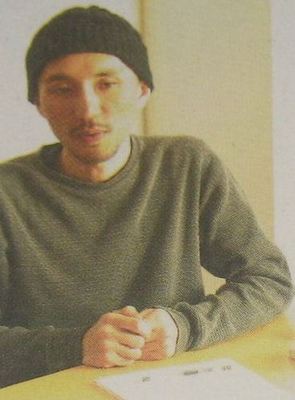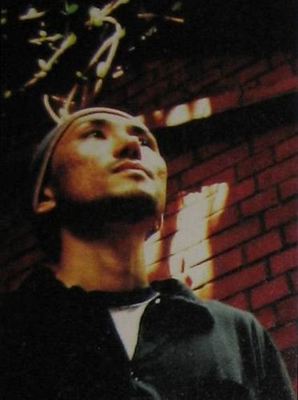Portraying the "fear" ingrained in Japan's humid climate

Art direction: Isao Takahashi
The art director of Siren. He joined the gaming industry after having a career in the TV commercial world. He was in charge of scenery on Silent Hill and Yoake no Mariko.
Mr. Takahashi joined the Siren team midway through. However, he is old friends with director Toyama and background/scenario head Sato. Together they worked on Silent Hill at Konami, and seem to be highly attuned to each other. With Toyama and Sato - who "suddenly rush off ahead with crazy ideas" (Takahashi) - he apparently thought that another of his roles was to "look at things from the viewpoint of what was realistic, sometimes dragging them back".
-- Mr. Takahashi - you worked as art director on Siren. How did you end up becoming involved in the project?
Takahashi: I joined a little late, after the project had already begun. The core parts of the game, like its overall plan and direction, had already been decided to a degree when I joined. When I heard the details of the proposal, I thought it sounded quite interesting.
-- So the game's outline had already been settled on to some stage by the point when you joined: at that point, how was the game explained to you?
Takahashi: First I was told something like, "It's a group performance-styled horror game set in a rural Japanese village." By that point, although it was really rough, they were creating a level as a playable demo. This meant that first of all, they showed me that so I could get a grasp of the game's image.
-- What was the demo version like?
Takahashi: The level was slightly different from what was eventually included in the game, but the geography was that of the rice fields level. The finer mechanics were different, but you could clearly see the idea of weaving your way between Shibito using sightjack taking shape. When I saw it, the visual image of Japan's unique climate, even the foggy, sticky humid feeling made a really strong impression on me. I liked the direction it was going in, so I decided to help to strengthen it through art direction.
Also, by that point Toyama (the director) and Sato (background, scenario) had a load of photos they'd taken in all places across the country they had been to, so I took a look through them. Among them, I saw some they said had been taken on an isolated island in western Japan of abandoned, ruined rice fields and a church... It was like a eureka moment. I felt like that was the moment when I got a firm idea of Siren's visual image.
-- What kind of job, generally, is the role of art director, as you were for Siren?
Takahashi: Basically, the job involves overall bringing together the information the player sees as they play the game, such as the main and in-game screens, as well as map, status and other things.
-- You have so far been in charge of the scenery for Silent Hill and Yoake no Mariko as far as games go. Comparing "scenery" and "art direction", how does your work change overall?
Takahashi: Taking charge of scenery, simply put, means everything you see in the game, so it means having what is relatively the biggest part to oversee. In the case of art direction, it doesn't stop with "portraying" things, like modelling the characters and Shibito and their movements, but you also have to include how objects move.
-- How did you find actually directing for yourself?
Takahashi: Directing the menu screen and all output sections like the visual interface was a really worthwhile experience. Even making it all uniform was really easy...
-- As someone who has played Siren, I think it's a unique game that leaves an impression you won't find anywhere else. I'm sure there must have been things you struggled with...
Takahashi: We did do a lot of things on Siren that you wouldn't usually do (laughs). The sightjack system itself is quite innovative, and you have absolutely no on-screen information about your health, score or anything else. Your character's current position isn't even displayed on the map, I hear (laughs). This kind of "complete nothingness" was something Toyama was intent on. We called it "blocked expression", but it's basically supposed not to pander to players. For example, if you lose some stamina, the shoulders of your on-screen character heave as if they're struggling, and they walk more slowly. Generally we wanted to try to show information through this kind of "image", though that alone requires more graphical components... We were trying to show using images what you would normally display using a gauge.
-- Did the graphical side of things require much figuring out?
Takahashi: Yeah. For example, sightjacking... the screen where you can steal others' vision. Since Siren is an action game, we had to make it so that you could get a certain grasp on your enemy's position in relation to yours, but the vision you see worsens in response to things such as distance from the other person... generally speaking, it makes the image get crackly... but we have that. That noise is applied later using a filter to create the effect, but if you go overboard then you don't get any actual visual information. However, if you can see too clearly then they kind of lose their character as being visions. That relationship was one of the things we did over a lot of times.
-- I see. Did you really put that much toil into a single visual element during visions?
Takahashi: Eventually we settled on having the images you see while sightjacking have filters applied to them, which makes the corners get darker until the borders are blurry, but you can still clearly make out the image. For parts of this, we used the cursed video tape from the film The Ring as guidance. The cursed tape basically gives you information on what someone else (Sadako) sees, except that the "visions" here are of information you obtain by consciously stealing their sight.

Mr. Takahashi ultimately holds responsibility for the game's graphics in general. He says in particular that he was fussy about the brightness of the screen until the very end. At the beginning of development the darkness really was quite dark, and, "That is what it's really like, but I thought it would be a bit harsh from a gaming perspective, so I made it brighter." (Takahashi) Siren is also incredibly detailed with how its levels fit on the timeline, so they even apparently argued abut how bright it would be around 5 in the morning.
-- I think the method employed in Siren of using photo data to create a character makes it feel unique...
Takahashi: It does. It's standard procedure to capture and reproduce the movements of actors using motion capture, but I don't think many people painstakingly model their characters based on photo data.
-- What led you to choose this method?
Takahashi: Toyama said that he wanted the characters played by actual actors (laughs). I guess that even when directors want something like that, they'll use actors for the voices and leave it at that. With Siren, however, we started looking into whether we could actually do something to put the actors themselves into the game. That kind of thing is Siren all over (laughs). In general, we photographed the actors from all angles to create textures from, then pasted those onto 3D models based on the actors' figures. For this, we had the actors wear costumes like you would when filming a movie, which may have had a crease or two over time, but were the real thing.
The characters' facial expressions were also made from textures of the actual actors' expressions that were pasted on. Human faces are symmetrical on either side, so most facial textures are captured on one side only. With Siren, though, we captured their entire faces in each image. So when, for example, Shibito shout, their faces actually make a different shape (laughs). We decided we had to do that if we were going to change their expressions as they shouted. For the same reason, the player characters also have quite individual, intense expressions. If we only used half of their faces, we wouldn't have been able to make them look so vivid.
-- I hear you originally started out in the TV commercial industry before switching to gaming?
Takahashi: Yes, that's right.
-- Both jobs involve video, but I imagine they're quite different.
Takahashi: Yeah; the difference between CG and live-action is huge. When I first became involved in creating games, "video" now meant "CG", and the first thing I felt was discomfort. The concept of "lenses" doesn't exist in CG... For example, if we filmed me being interviewed now with a camera, the back wall would be blurry and out of focus. But with CG, pretty much everything on-screen is in focus. To make CG feel out of focus requires intentional processing using something like filters. This is a pretty unnatural sensation for me (laughs). It has a way of making people feel uneasy.
-- You mean images that are distinct all over make people uncomfortable?
Takahashi: Yeah. To give you an example, I guess it's quite similar to the works of photographer Ansel Adams. He was a cameraman who primarily photographed scenery, who preserved the scenery of things like Yellowstone National Park in America - anyway, he employed a variety of techniques to make photos that were sharp and clear all over. They're very beautiful, but they're all so sharp that they can make people who look at them feel uneasy.
Junji Ito's manga is the same. I feel such horror in his manga, which is due to the style he draws in. For example, in a scene where two characters are having a conversation, the grains of wood on the posts behind them are intricately drawn... The density that comes from such an extreme style of drawing ends up creating an uncomfortable feeling. The kind of feeling where it's a landscape you know well, but something is kind of different. I think that might be the ultimate element in horror.
My design comes from lowering saturation and using low-toned colours. I guess its something like period dramas on captured on film as opposed to taped TV dramas these days. I think that it's quite a good fit for showing Japan's unique climate and a sense of noise. By combining those tones with the traits of CG that I mentioned earlier, I was quite satisfied with what I did on Siren. I hope everyone plays the game again, looking at it in this way.
English Translation by Chelsea

